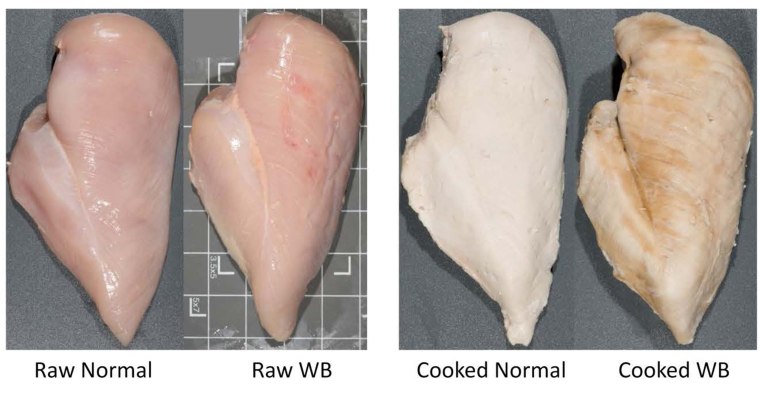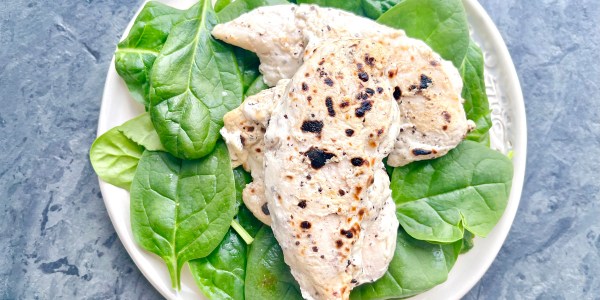Noticing that your chicken breasts have an unpleasant texture these days? You're not alone. This weird phenomenon is known as woody chicken breasts. "Woody breast is an ongoing challenge facing the entire industry," Michelle Babin, a spokesperson for Perdue Farms, told TODAY Food. "It's something all poultry producers have been working to resolve."
While humans have been eating chicken for 2,200 years, woody breasts are relatively new. "We’ve only been dealing with woody breasts for about eight years," says Dr. Casey Owens, Professor of Poultry Science at the University of Arkansas. She told TODAY she's seen it affect anywhere between 5-30% of birds. While researchers and geneticists attempt to find the exact cause — and cure — here's what you need to know.
What are woody chicken breasts?
According to the National Chicken Council, a woody breast is when chicken breast meat is "hard to the touch and often pale in color with poor quality texture." It's commonly confused with white striping, which is when fat replaces muscle tissue. However, a woody chicken breast is characterized by a tougher or, as Owens likes to say, "more complex" consistency. Woody chicken breast meat is more coarse with fibers that feel "woody" — hence the name. This woodiness is not found in thighs, wings or other cuts.

What causes woody chicken breasts?
Scientists are still working on finding the root cause of woody chicken breasts. But based on her research, Owens believes woody breasts are related to the development of the muscle. "If birds are growing really efficiently and fast, they're synthesizing muscle and that adds stress. That stress results in degradation of protein so the composition changes and you get collagen and fat that moves into the muscle." According to Owens, a woody chicken breast may have 2% less protein than a normal breast.
Woody breasts are more common in older and bigger birds. They also tend to be more prevalent in chickens raised for commercial production. "Broiler breeds have a long history of genetic modifications to improve their productivity," Amber Rogers, an environmental scientist and the founder of My Chicken Guide, told TODAY. In 20 years of breeding free range heritage breeds, she's seldom encountered the issue. "The advice I'd give to growers to ensure their chickens don't develop woody breasts is to allow their flocks to maintain natural growth patterns."
How to avoid buying woody chicken breasts
Although producers are hyper aware of woody chicken breasts and are employing new sorting technologies to weed them out, woody breasts are perhaps more prevalent than they've ever been. It's why Greg Caggiano stopped buying non-organic chicken. "It seemed like one out of every four breasts I was getting were affected," the food writer told TODAY. "It was unavoidable." These days, Caggiano only buys organic chicken breasts, and he seldom gets woody breasts. "I pay close to double what I used to pay when I was buying non-organic, but for me, it’s worth it."
In addition to looking for smaller breasts (which organic breasts tend to be), it's helpful to feel the meat. "In inspecting fresh chicken breasts in the package, it would be harder to the touch if the breast had the condition," Tom Super, Senior VP of Communications at the National Chicken Council, told TODAY.
Another thing to look for? Color. "When selecting fresh chicken, check for discoloration," chef Matt Horn, a James Beard-nominated pitmaster, told TODAY. "It should have a pink hue with a firm texture and plump appearance." Unfortunately, if you're buying frozen chicken breasts, you likely won't know if any are woody until you defrost them.
What can you do with woody chicken breasts?
While they make for less-than-stellar filets, woody chicken breasts aren't completely worthless. Consider trying to tenderize them by using a marinade or brine with yogurt or buttermilk — which has enzymes that make the meat less tough.
"My favorite method for fixing woody chicken breast is to marinate it in a yogurt-based sauce," Jessica Randhawa, head chef and recipe creator at The Forked Spoon, told TODAY. "If you end up with a woody chicken breast, marinate the chicken, overnight if possible, in yogurt mixed with your favorite seasoning or spices," You can also always turn a woody breast into ground chicken and use it in chicken burgers, where the texture is more masked.
Of course, you don't have to eat the meat if you don't want to. "I don't even try to soften woody chicken, as texture is so important and not an easy fix," chef Brian Malarkey, "Top Chef" finalist and Chefs Life founder, told TODAY. "In other words, it's Fido's lucky day!"
